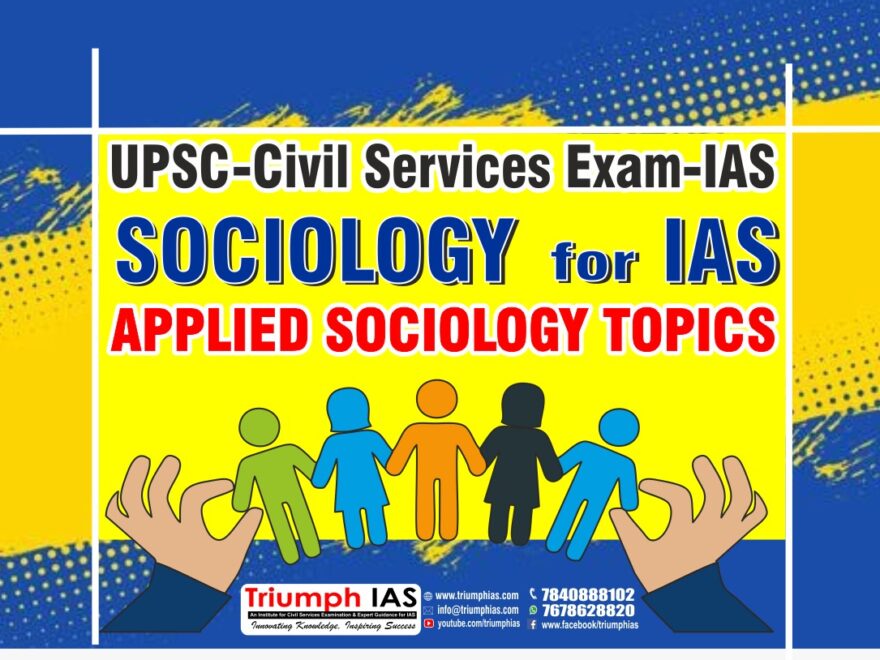UPSC-Civil Services Exam-IAS
Sociology For IAS “APPLIED SOCIOLOGY TOPICS”
Social Change and its Impact on Modernization
The essays in the book aim to explore the idea of modernization from a ‘systematic sociological perspective’. Singh’s imagination of modernization in the Indian context is rooted in the twin phenomena of ‘social structure’ and ‘tradition’. Following a critique of erstwhile sociological interpretations of Indian modernization as being simply blinded by nationalist agenda, he proposes the study of modernization from a socio-historiographical point of view.
For ease of understanding, Singh further divides both social structure and tradition into ‘macro-structures’ and ‘micro-structures’ and ‘little traditions’ and ‘great traditions’, respectively. This enables readers to engage with the complex historiography of Indian society more holistically and comprehensively. Moreover, this paradigm of understanding social structures and traditions highlights several aspects of social change that seeks to move beyond simply descriptive interpretations and replaces them with series of critical analyses
Inducing his ideas from the works of sociologists like Louis Dumont and Talcott Parsons as well as several other early thinkers of Indian sociology like G.S Ghurye, M.N Srinivas, D.P Mukherjee, Singh offers a mostly structural-functionalist and positivist depiction of Indian modernization.
An Analysis of Yogendra Singh’s ‘Modernization’
To explain modernization in the Indian context, Singh employs a method of looking at ‘internal’ and ‘external’ developments in the socio-cultural and political history of the Indian subcontinent. Within both social structures as well as tradition, he believes that modernization occurs through a series of ‘orthogenetic’ or the ‘internal’ socio-cultural transitions as well as ‘heterogenetic’ or the ‘external’ transitions. Accordingly, Singh believes that for understanding Indian modernization, it is necessary to study the cultural synthesis of both the orthogenetic as well as heterogenetic forms of social change and their respective impacts on Indian society.
Singh uses an integrative approach by critically reviewing and incorporating previously studied dichotomies such as ‘Sanskritization’ vs ‘Islamization’, ‘Sanskritization’ vs ‘Westernization’, ‘Great’ and ‘Little’ traditions as well as ‘universalization’ vs ‘parochialization’ to study the nature of social change in Indian society. However, he believes that it is inadequate to study concepts like Sanskritization and Westernization only in the context of social change and wishes for them to be examined even in the context of ‘tradition’.
Interpretation of the External vs Internal Factors of Changes in Indian Society
As explained previously, in the book Singh has named the external and internal factors of change in Indian society as ‘heterogenetic’ and ‘orthogenetic’ changes, respectively. In the designated chapter titled ‘Orthogenetic Changes in Cultural Traditions and Modernization’, the author has tried to explore the Cultural renaissance that Indian society underwent with the onset of the spread of Jainism and Buddhism.
Here, he notes that the exchange of cultural ideas between these two religions and Hinduism itself brought about a dynamic change within the socio-cultural fabric of Indian society, especially in terms of the caste system and the varna system. While talking about both Hinduism and Islam, Singh has explained the difference between ‘great’ and ‘little’ traditions in both cultures. Here, they signify the difference between core concepts like socio-cultural interactions between people, the rules of social order, etc which are strongly intrinsic to the respective religions and the difference between the adaptive changes in family, marriage and kinship structures that both religions underwent, especially when they came in contact with one another during the period of ‘Islamization’.
Singh has strongly tried to differentiate between religions of Indian or ‘Dharmic’ origin and religions that originated outside the Indian subcontinent (such as Islam, Judaism and Christianity). The purpose of this has been to trace the contrasts in the way that each religion has impacted the socio-cultural changes in Indian society. Interestingly, Singh argues that while values of modernity (the state of having ‘modern’ ideas, rooted in scientific thought and rationalism) have been brought about by introducing egalitarianism and greater socio-cultural flexibility, this scientific thought and social egalitarianism do not need to be interdependent on one another for a society to be known as ‘modern’.
To further explain this point, Singh (1973) says “It is otherwise possible that a successful scientist may be a failure as a modern human and a most affluent or technologically advanced society may also be the one which is the most tyrannical.” Naturally, this acts as a disclaimer to note that the idea of modernization itself, is a very value-added concept and Singh seeks to warn us, despite a very positivist approach to the idea of modernization that it cannot be looked at from a neutral stance.
Finally, the book also explores changing trends in social institutions of family, village, and caste, that is, changes in the micro and macro structures. Especially in terms of family and caste, these changes are marked with increased mobility in the ascribed and acquired the status of individuals, many of which have been facilitated by rules of marriage and kinship among various communities.

